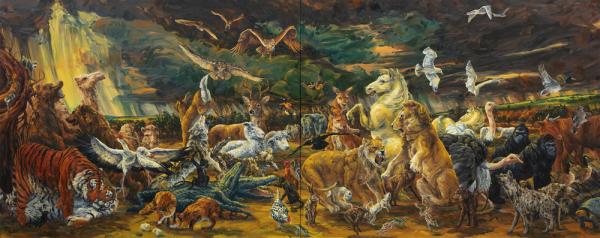Skip to main content
The Ark
Artist
Melissa Miller
(American, born 1951)
Date1986
MediumOil on linen
DimensionsOverall: 67 x 168 x 1 5/8 in. (170.18 x 426.72 x 4.13 cm)
Credit LineCollection of the Modern Art Museum of Fort Worth, Museum purchase, The Benjamin J. Tillar Memorial Trust
Object number1986.17.A-B
Status
Not on viewSignedrecto l.r.c. "MWM"
verso left panel on stretcher "Melissa Wren Miller 1986"
verso right panel on stretcher "Melissa W. Miller 1986 'The Ark' "
Copyright© Melissa W. Miller
Category
Label TextIn Melissa Miller’s fourteen-foot-wide diptych The Ark, 1986, pairs of animals gather in an open prairie under a wild sky of black, blue, and harsh green clouds. A curtain of fast-approaching rain stretches across the horizon. A horse rears up. Tigers quietly nestle. Monkeys engage in monkey business, playing around the mouths of crocodiles. For Miller, raised in a church-going Texas family, Old Testament subjects have long been fodder for the imagination. Noah does not figure in her painting of the biblical procession, however, nor does the ark, which is suggested only by a plank boardwalk rising toward the right edge of the canvas. This is not an orderly two-by-two march but a scene of pandemonium at a moment between doom and salvation. The animals in The Ark are not just species in a menagerie, but the conveyors of themes of control and disruption, curiosity and observation, risk and temptation, and couples’ tender or antagonistic interactions.
The Ark is also layered with references to art history, from Renaissance battle scenes to Dutch genre paintings to the dramatic tableaux of the French Romantics. Miller lifted many of the animals in The Ark directly from historical paintings by Gustave Courbet, Eugène Delacroix, Théodore Géricault, George Stubbs, and others, while the influence of Abstract Expressionism endures in Miller’s vigorous, open brushwork. Miller’s interpretation of the impending Flood is a perfect storm of past sources and present emotion, metaphor and meaning, chaos and fragile harmony.
The Ark is also layered with references to art history, from Renaissance battle scenes to Dutch genre paintings to the dramatic tableaux of the French Romantics. Miller lifted many of the animals in The Ark directly from historical paintings by Gustave Courbet, Eugène Delacroix, Théodore Géricault, George Stubbs, and others, while the influence of Abstract Expressionism endures in Miller’s vigorous, open brushwork. Miller’s interpretation of the impending Flood is a perfect storm of past sources and present emotion, metaphor and meaning, chaos and fragile harmony.









